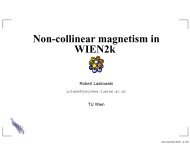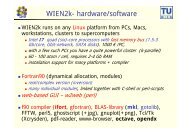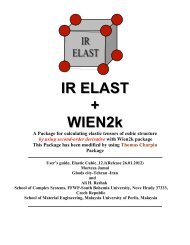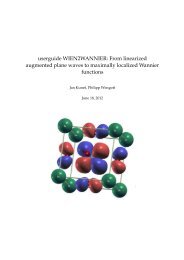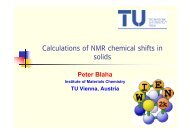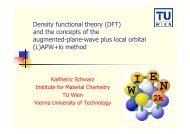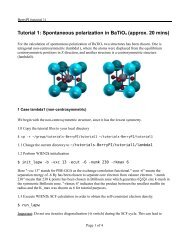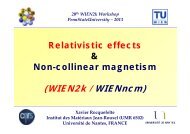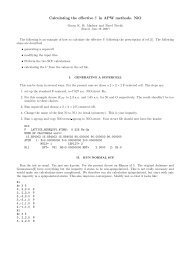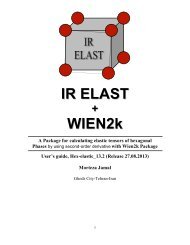2. Optical Properties of Solids - WIEN 2k
2. Optical Properties of Solids - WIEN 2k
2. Optical Properties of Solids - WIEN 2k
- No tags were found...
Create successful ePaper yourself
Turn your PDF publications into a flip-book with our unique Google optimized e-Paper software.
<strong>Optical</strong> <strong>Properties</strong> <strong>of</strong> <strong>Solids</strong>Claudia Ambrosch-DraxlChair <strong>of</strong> Atomistic Modelling and Design <strong>of</strong> MaterialsUniversity Leoben, Austria
OutlineBasicsProgramExamplesOutlooklight scatteringdielectric tensor in the RPAsumrulessymmetrythe band gap problemprogram flowinputsoutputsconvergenceresultsapplicationsbeyond linear opticsbeyond RPAOptics in <strong>WIEN</strong><strong>2k</strong>
OutlineBasicsProgramExamplesOutlooklight scatteringdielectric tensor in the RPAsumrulessymmetrythe band gap problemprogram flowinputsoutputsconvergenceresultsapplicationsbeyond linear opticsbeyond RPAOptics in <strong>WIEN</strong><strong>2k</strong>
<strong>Properties</strong> & ApplicationsDielectric function<strong>Optical</strong> absorption<strong>Optical</strong> gapExciton binding energyPhotoemission spectraCore level spectraRaman scatteringCompton scatteringPositron annihilationNMR spectraElectron spectroscopyLight emitting diodesLasersSolar cellsDisplaysComputer screensSmart windowsLight bulbsCDs & DVDsunderstand physicscharacterize materialstailor special propertiesExcited States
Light – Matter InteractionResponse to external electric field EPolarizability:Linear approximation:Fourier transform:susceptibility χconductivity σdielectric tensor∋<strong>Optical</strong> <strong>Properties</strong>
The Dielectric TensorFree electrons: Lindhard formulaBloch electrons:Interband contribution:intrabandinterband<strong>Optical</strong> <strong>Properties</strong>independent particle approximation, random phase approximation (RPA)
<strong>Optical</strong> "Constants"Complex dielectric tensor:Kramers-Kronig relations<strong>Optical</strong> conductivity:Complex refractive index:Reflectivity:Absorption coefficient:Loss function:<strong>Optical</strong> <strong>Properties</strong>
Intraband ContributionsDielectric Tensor:Drude-like terms<strong>Optical</strong> conductivity:Plasma frequency:Metals
Sumrules<strong>Optical</strong> <strong>Properties</strong>
Symmetrytriclinicmonoclinic (α,β=90°)tetragonal, hexagonalorthorhombiccubicDielectric Tensor
Magneto-opticswithout magnetic field, spin-orbit coupling:cubicKKwith magnetic field H װ z, spin-orbit coupling:KKtetragonalExample: NiKK
Be careful ....
Wavefunction vs. DensityHartree-Fock:ionization energiesDFT:Lagrange parametersauxiliary functionsKoopman's theoremJanak's theoremExcited States
Open QuestionsApproximations used:Ground state:Excited state:Local Density Approximation (LDA)Generalized Gradient Approximation (GGA)Interpretation within one-particle pictureInterpretation <strong>of</strong> excited states in terms <strong>of</strong> ground state propertiesElectron-hole interaction ignored (RPA)Where do possible errors come from?How to treat excited states ab initio?Excited State <strong>Properties</strong>
The Band Gap ProblemIonization energyElectro-affinityBand gapshift <strong>of</strong> conduction bands: scissors operatormany-body perturbation theory: GW approach
OutlineBasicsProgramExamplesOutlooklight scatteringdielectric tensor in the RPAsumrulessymmetrythe band gap problemprogram flowinputsoutputsconvergenceresultsapplicationsbeyond linear opticsbeyond RPAOptics in <strong>WIEN</strong><strong>2k</strong>
Program FlowSCF cycleconverged potentialkgenlapw1lapw2opticjointkramdense mesheigenstatesFermi distributionmomentum matrix elementsdielectrix tensor componentsRe ε Im ε optical coefficientsbroadeningscissors operatorOptics in <strong>WIEN</strong><strong>2k</strong>
al.inop"optic"2000 1 number <strong>of</strong> k-points, first k-point-5.0 <strong>2.</strong>2 E min, E max: energy window for matrix elements1 number <strong>of</strong> cases (see choices below)1 Re OFF unsymmetrized matrix elements written to file?ni.inop (magneto-optics)800 1 number <strong>of</strong> k-points, first k-point-5.0 5.0 Emin, Emax: energy window for matrix elements3 number <strong>of</strong> cases (see choices below)1 Re 3 Re 7 Im OFFChoices:1......Re <strong>2.</strong>.....Re 3......Re 4......Re 5......Re 6......Re 7......Im 8......Im 9......Im Inputs
al.injoint"joint"1 18 lower and upper band index0.000 0.001 1.000 E min, dE, Emax [Ry]eVoutput units eV / Ry4 switch1 number <strong>of</strong> columns to be considered0.1 0.2 broadening for Drude modelchoose gamma for each case!SWITCH0...JOINT DOS for each band combination1...JOINT DOS sum over all band combinations<strong>2.</strong>..DOS for each band3...DOS sum over all bands4...Im(EPSILON) total5...Im(EPSILON) for each band combination6...INTRABAND contributions7...INTRABAND contributions including band analysisInputs
"kram"al.inkram0.1 broadening gamma0.0 energy shift (scissors operator)1 add intraband contributions 1/01<strong>2.</strong>6 plasma frequency0.2 gamma(s) for intraband partas number <strong>of</strong> columsas number <strong>of</strong> columsDielectric function8070 Silicon60504030ImεReε20100-10Γ=0.05eV-200 1 2 3 4 5 6Energy [eV]si.inkram0.05 broadening gamma1.00 energy shift (scissors operator)0....Inputs
opticcase.symmatcase.mommatmomentum matrix elements, symmetrizedanalysis, NLOcase.jointIm εjointSWITCH 4case.epsiloncase.sigmakcase.refractioncase.absorpcase.elosskramcomplex dielectric tensoroptical conductivityrefractive indexabsorption coefficientloss functionOutputs
OutlineBasicsProgramExamplesOutlooklight scatteringdielectric tensor in the RPAsumrulessymmetrythe band gap problemprogram flowinputsoutputsconvergenceresultsapplicationsbeyond linear opticsbeyond RPAOptics in <strong>WIEN</strong><strong>2k</strong>
Results ....
ConvergenceInterband Im ε175150125100755025165k286k560k1240k2456k3645k4735k1<strong>2.</strong>81<strong>2.</strong>71<strong>2.</strong>6ω p1<strong>2.</strong>51<strong>2.</strong>41<strong>2.</strong>31<strong>2.</strong>21<strong>2.</strong>11<strong>2.</strong>00 1000 2000 3000 4000 5000k-points in IBZ00.0 0.5 1.0 1.5 <strong>2.</strong>0 <strong>2.</strong>5 3.0 3.5 4.0Energy [eV]Example: Al
N eff[electrons]54321Sumrules165 k-points4735 k-pointsExperiment00 10 20 30 40 50 60 70 80 90 100Energy [eV]Example: Al
Loss Function120100Loss function80intraband6040total20interband00 5 10 15 20Energy [eV]Example: Al
Theory - ExperimentExample: PlatinumK. Glantschnig, and C. Ambrosch-Draxl, (preprint).
C. Ambrosch-Draxl and J. O. S<strong>of</strong>oComp. Phys. Commun., in print



